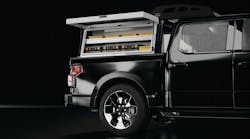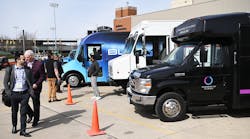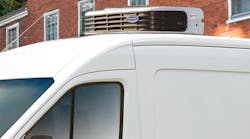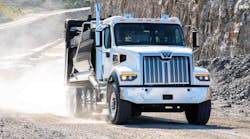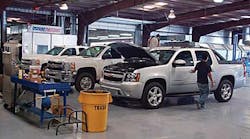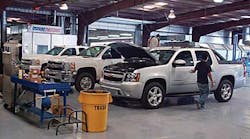Falling off a roof may have ended Jimmie Carter's roofing career, but his fall many years ago accident led to the launch of several successful business ventures involving trucks and truck equipment.
After dusting himself off, Carter climbed quickly. Living at a room at the local YMCA, he began a new path, one that started with a job dusting the parts bins in a International dealership. Eventually he opened a dealership of his own — Carter Chevrolet — and his own truck equipment company — OEM Systems in Okarche, Oklahoma. OEM Systems has become a major upfitter of truck equipment and a significant player in the growing field of CNG conversions.
Located about an hour west of Oklahoma City, OEM Systems has been building momentum as a fuel systems converter ev
er since it installed its first CNG system in 2007. The company converted seven vehicles that year, followed by another 100 in 2008. In 2011, OEM Systems switched 1,000 vehicles to run on compressed natural gas. An
d with it's participation as an installer for the Ford Gaseous Fuel Qualified Vehicle Modifier (QVM) program, the pace is only going to accelerate. As of March of this year, the company has completed more than 3,000 CNG conversions.
Only last year, converting 2,000 gas-powered vehicles to CNG was enough of a milestone for OEM Systems to hold a special ceremony to commemorate it. The event, held in February 2012, was at OEM's facility in Okarche and included guests such as customers, suppliers, chassis manufacturers and government officials. The area's state representative addressed the crowd. Lisha Oshman, owner of OEM Systems, also spoke as did a representative of Chesapeake Engergy, the customer that first asked OEM Systems if they could convert a truck to burn compressed natural gas in a vehicle. That afternoon the governor of Oklahoma presented OEM Systems with a gubernatorial commendation at the Oklahoma State Capitol for their contribution to the CNG industry. The afternoon event attracted government officials at multiple levels. Including Oklahoma Secretary of Agriculture who received the keys to OEM's 2,000th conversion from the Governor at the ceremony.
OEM Systems has developed a reputation for its work with compressed natural gas fuel systems.
“We are known for our ability to customize,” Robinson says. “We can install a single request or 500 vehicles at a time. While OEM typically converts trucks, SUV's and fleet cars, occasionally they have they opportunity to convert rare vehicles to CNG such as a Chevrolet Calloway Camero for Chesapeake Energy. A well-equipped fabrication department helps OEM Systems do even more with CNG. The company manufactures many of the brackets and other small parts required to make the conversions. It's an additional use for equipment that the company already had in place to fabricate parts for truck equipment installations.
The warehouse handles an estimated 8,000 part numbers.
“We tie in everything to the VIN number,” says Chad Kisinger, director of natural gas vehicle operations. “Even a one-off part gets a number.”
Making it work
Equipping a truck to run on compressed natural gas is a team effort. OEM Systems starts with a CNC underhood system manufactured by various CNG system manufacturers. The kit includes injectors, the engine control unit, high-pressure lines, and regulator.
The company then does the installation, integrating the components into a seamless fueling system that can be either a dedicated CNG system or operate on both CNG and gasoline.
A range of fuel tanks are offered in the industry. Type 1 tanks are made of steel and are rated to 3,000 psi. Type 2 and 3 tanks are made of aluminum and wrapped with fiberglass. Type 4 tanks are similar in construction to the Type 3 tanks but have polystyrene foam protecting the ends. Both of these types of tanks are capable of handling the 3,600-psi pressures that are standard in today's CNG-fueled vehicles.
Once completed, the vehicles move to quality control. As part of the process, each one is driven 40 miles to verify that it is performing properly.
In February, OEM Systems became a ship-through location for GM trucks. The company's location is in Union City, Indiana. OEM will add aftermarket truck equipment to the 6.0L three-quarter ton pickups with CNG conversions provided by GM
For everything else — from Calloway Camaros to one-ton trucks — the conversions and truck equipment installations are performed in the company's 100,000-sq-ft truck equipment shop in Okarche.
OEM Systems is a full-line truck equipment distributor for Reading Truck Body. The company's truck body offerings include service bodies, dump bodies, enclosed bodies, stake and platform bodies. Pickup accessories, van interiors, liftgates, electrical components, tarp systems, and hitches are other popular products that OEM Systems provides and installs.
“Our ‘one-stop shop’ concept helps,” Oshman says. “Regardless of the chassis, we can work with the customer. If he has one truck or a thousand, we can help.”
Back to the fall
Following his fall, Carter got a room at the YMCA and a job dusting the shelves at an International dealer. It wasn't long before he was waiting on customers and offering suggestions for ways to help them save money on their parts purchases.
“People began asking for him to sell them trucks, but the response was that he was not a salesman,” Oshman recalls. “Customers would respond, ‘But he takes good care of me.’”
Carter did make it onto the sales floor and earned a good living selling Chevrolets. Eventually he was responsible for 40% of the trucks that the dealership sold, Robinson says. In 1973, he gave up the security of selling for an established dealership and moved to Okarche to go into business for himself.
“He was always a risk-taker and a gambler,” Oshman says. “In the early days of the dealership, he did it all — bidding, ordering, delivering the truck to the customer. He would then come back and do it all over again.”
Carter also started its own logistics company. A fleet of eight tractors and trailers delivers new trucks and picks up old ones, helping customers find buyers for their used equipment.
“People want us to do it all,” Oshman says. “Carter taught us a lot about helping people. He really set our family and company up for success.”
__________________
Click here to view all large photos and captions
for OEM Systems

